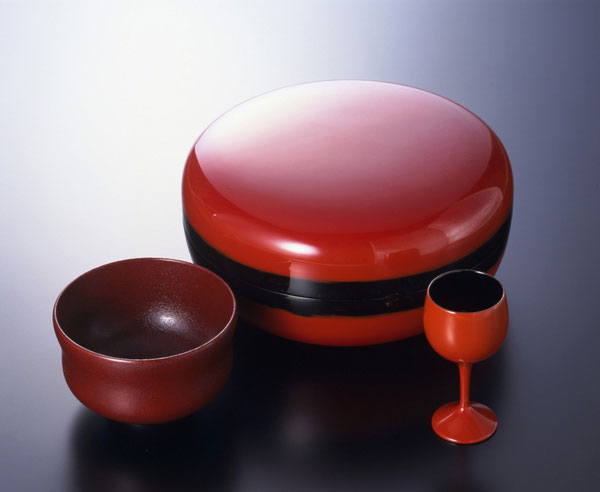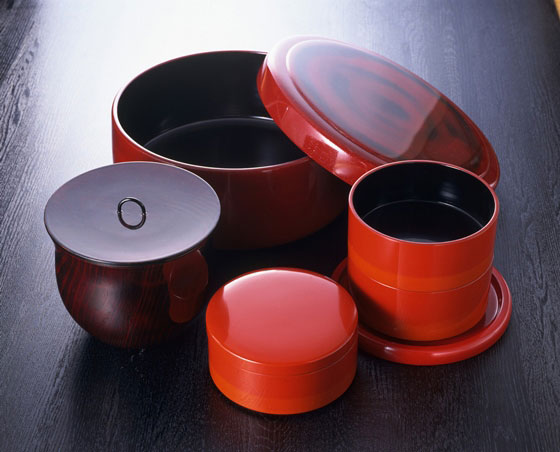
- Lacquerware
- Niigata
Niigata lacquerware Niigata shikki
A treasure trove of various coating techniques
that were born from cultural exchange
Description
What is Niigata lacquerware ?
Niigata Lacquerware (called Niigata Shikki in Japanese) is a form of lacquerware produced in the area around the city of Niigata, Niigata prefecture. This craft has various coating techniques such as hana-nuri, ishime-nuri, nishiki-nuri, isokusa-nuri and take-nuri, so a great variety of styles can be enjoyed. Hana-nuri has simple beauty and luster, as no patterns are applied. Ishime-nuri has a stone-like roughness, with the coating providing a hard surface that is resistant to scratching. Nishiki-nuri involves repeated coating of colored lacquer with a wad of hemp cord, after which the surface is polished to make a mottled pattern in the various layers of lacquer. Like nishiki-nuri, isokusa-nuri also uses multiple layers of colored lacquer, but a board-shaped wad is used which makes a pattern that looks like seaweed swaying between waves. Take-nuri, where bamboo nodes and soot-stained impressions are drawn with lacquer, is the most representative technique of Niigata lacquerware. Additionally, there are various traditional lacquering techniques such as kinma-nuri, seido-nuri, aokai-nuri, roiro-nuri and shitan-nuri, as well as new lacquering techniques like yuhi-nuri.
History

For a long time, the city of Niigata has been the center of trade where cultures from various places arrive by sea or land, with lacquerware being one of these imports. The history of this craft is said to have originated between the years 1615 and 1624, when shunkei-nuri, a lacquerware technique from Akita prefecture, was introduced. Initially, production was centered on items for daily use such as serving trays and small dining trays. In 1638, a monopolized sales region of lacquerware called Wandana was established in Niigata, assuring the production of lacquerware. The technique of maki-e* was imported between 1764 and 1771 while coating techniques unique to Niigata such as isokusa-nuri (elaborate patterning) and kinma-nuri (colored lacquer painted in cut-away areas) were created at the beginning of the 19th century. Since Niigata was a port of call for cargo ships sailing the Sea of Japan at that time, the market expanded to various other parts of Japan, including Tokyo and Osaka, so that by the end of the Edo period (1603-1868), Niigata had become Japan’s leading area of lacquerware production. Take-nuri, a technique to finish the lacquer coating with a bamboo-like appearance, was introduced in the middle of the Meiji period (1868-1912), and this became the technique most widely associated with this craft. The range of coating techniques for Niigata lacquerware are a result of absorbing technologies from various regions and the efforts of the people who developed them.
*Maki-e involves using a fine brush to paint a picture with lacquer on the surface of a vessel, and then sprinkling gold powder on the surface before it dries, creating a design
General Production Process
- 1. Hardening the wood
Raw lacquer is applied to the material so that it absorbs enough to produce a waterproof effect. For materials with joints, the joints are reinforced as necessary by attaching cloth with noriurushi, which is a kneaded mixture of raw lacquer and rice paste. If there are cracks or scratches on the material, the surface is conditioned by embedding kokuso, a kneaded mixture of raw lacquer, cooked rice paste, wheat flour, and wood meal.
- 2. Applying rust lacquer
Baked and purified diatomaceous soil called jinoko or grit stone powder called tonoko which is produced when cutting out a grit stone is kneaded with water and mixed with raw lacquer to produce a clay undercoating called rust lacquer. A spatula or similar utensil is used to evenly rub the rust lacquer across the entire material. After it dries and hardens, the surface is wet sanded, smoothened and polished with a wet whetstone or waterproof sand paper. In order to strengthen the material and stabilize its shape, these steps are repeated multiple times.
- 3. Bamboo composition
Rust lacquer is applied to the surface of the material using a special spatula, making protrusions that resemble bamboo nodes. The parts that become bamboo node grooves are cut with a chisel to create a shape that resembles bamboo nodes. Detailed parts such as bamboo branches and roots are also produced by applying rust lacquer.
- 4.Polishing the rust lacquered surface
After the rust lacquer dries and hardens, the surface is wet sanded and smoothened with wet whetstone or waterproof sand paper.
- 5. Intermediate coating
Lacquers that are the color of green bamboo, soot-colored bamboo, or sesame bamboo are used as necessary for an intermediate coating. The pieces are coated with the color lacquer using a paintbrush and are placed inside a cellar to dry. A specific humidity and temperature are required for the lacquer to solidify, so the humidity level of the cellar is maintained at around 70 percent and the temperature at around 20℃ (68℉).
- 6. Polishing the intermediate coating
After the intermediate coating dries and hardens, the surface is wet sanded and smoothened with wet whetstone or waterproof sand paper.
- 7. Final coating
Lacquers that are the color of green bamboo, soot-colored bamboo, and sesame bamboo are also used for the final coating. For the green bamboo and sesame bamboo colors, the same color lacquers used for intermediate coating are used. The soot-colored bamboo lacquer for the final coating has a slightly different mixture from the colored lacquer used for intermediate coating. The final coating lacquer is applied to all surfaces with a paintbrush, and the pieces are again placed in the cellar to dry. For the sesame bamboo color, charcoal powder is sieved and sprinkled onto the surface before the final coating colored lacquer dries, and the pieces are then placed in the drying cellar.
- 8. Polishing
After the final coating dries and hardens, the surface is wet sanded and smoothened with wet whetstone or waterproof sand paper.
- 9. Patterning
A textured pattern is applied to make the piece look like bamboo. The bamboo line patterns are applied using a tool to draw lines after wet sanding, or with a paintbrush when applying the final coating. The textures of other parts of the piece are created as necessary. Detailed grain patterns of a cross-section of cut bamboo or the cut ends of bamboo are depicted by applying viscous lacquer with a paintbrush or spatula. Little prickles or speckles around the nodes are drawn with a maki-e brush.
- 10. Sprinkling makomo
Transparent lacquer is applied mainly around the bamboo node parts to shade off the colors. While still partially dry, makomo (dried powder of Manchurian wild rice, a grass plant) is sprinkled with a paintbrush to produce a soot-stained impression. To make a soot-colored bamboo color, makomo is sprinkled on the whole piece. After applying makomo, the pieces are again placed in the drying cellar.
- 11. Wet sanding
A mixture of finely powdered polishing charcoal and water is applied with a paintbrush, and the surface that has been sprinkled with makomo is wet sanded. This removes any excess makomo and produces the natural texture of bamboo nodes.
- 12. Lacquer rubbing
Raw lacquer is applied and rubbed into the entire surface of the piece and it is then dried in the drying cellar. A glossy finish is achieved by lacquer rubbing multiple times.
- 13. Completion
Where to Buy & More Information
Nigata Shikki Dogyo Kumiai
-
Address
-
Tel.+81-256-775-450
-
Website
See more Lacquerware
- Wajima lacquerware
- Kamakura-bori lacquerware
- Tsugaru lacquerware
- Aizu lacquerware
- Yamanaka lacquerware
- Kawatsura lacquerware
- Echizen lacquerware
- Joboji lacquerware
- Kiso lacquerware
- Hidehira lacquerware
- Kagawa lacquerware
- Ryukyu lacquerware
- Takaoka lacquerware
- Wakasa lacquerware
- Hida-shunkei lacquerware
- Ouchi lacquerware
- Kanazawa lacquerware
- Kishu lacquerware
- Kyo laquerware
- Odawara lacquerware
- Naruko lacquerware
- Niigata lacquerware
- Murakami carved lacquerware
See items made in Niigata
- Ojiya chijimi textiles
- Shiozawa tsumugi silk
- Hon-shiozawa silk
- Ojiya tsumugi silk
- Niigata lacquerware
- Kamo traditional chest
- Murakami carved lacquerware
- Tsubame-tsuiki copperware
- Echigo-sanjo cutlery
- Tokamachi traditional resist-dyed textiles
- Nagaoka Buddhist altar
- Tokamachi akashi chijimi textiles
- Echigo-yoita cutlery
- Sanjo Buddhist altar
- Niigata-shirone Buddhist altar































































































































































































































































































